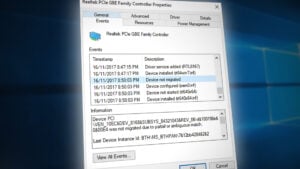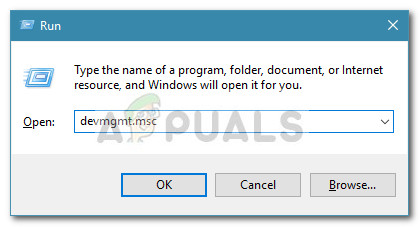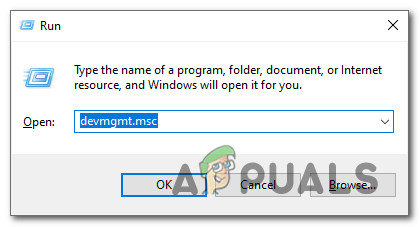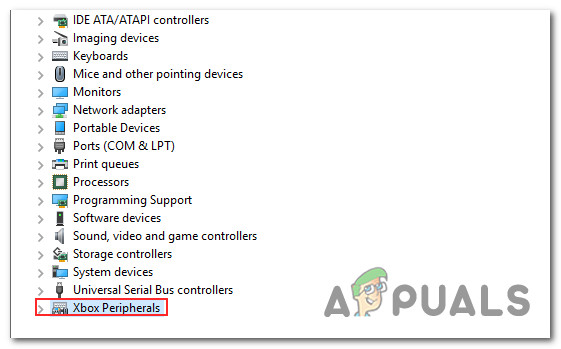How to Fix Xbox Controller ‘Device could not be migrated’ Error on Windows 10?
Some Windows 10 users are reporting that they are unable to pair their Xbox One or Xbox Series X controller with their PC. Most affected users are reporting that the full event log contains the error message ‘Device Could not be migrated‘.

After investigating this particular issue thoroughly, it turns out that there are several different common scenarios that might be triggering this particular error code. Here’s the full list of potential culprits that might be responsible for the apparition of the ‘Device could not be migrated’ error with Xbox controllers:
- Outdated controller firmware version – As it turns out, one of the most common instances that are known to produce this error code is a severely outdated firmware version of the Xbox Controller driver. A lot of affected users facing this problem have reported that they were finally able to fix the problem after they used Device Manager to update the driver version to the latest.
- Corrupted / Partially installed Xbox Controller driver – Under certain circumstances, you can expect to see this error occurring when your OS is attempting to use a corrupted or partially installed Xbox Controller driver. In this case, you can fix the problem by removing every remnant of the file and re-installing the latest driver version.
- Improper Xbox peripheral driver – In the past, there were several points in time where a new driver update caused connectivity issues with Xbox series X controllers. If this scenario is applicable and you want to avoid waiting on Microsoft to release a hotfix for this issue, you can fix the issue by rolling back to a more stable driver.
- Unstable BIOS version – As it turns out, you can also expect to see this problem due to a particular issue with the Basic Input and Output System that’s inhibiting your PC’s ability to accommodate new peripherals. Other users that were also encountering this issue have reported that they managed to fix this issue by updating your BIOS version to the latest release available.
Method 1: Updating the Driver Firmware of Xbox One Controller
If you’re encountering this issue while trying to connect the Xbox One Controller or the newest Xbox Series S controller via a wireless connection, the first thing you should do is make sure that the controller is using the latest available driver.
This can be done by utilizing Device Manager to scan for newer driver software and choosing to install the latest available version. Several affected users have confirmed that utilizing this method was the only thing that allowed them to resolve the ‘Device Could not be migrated‘.
Keep in mind that Microsoft has released a driver update to make the connection with the newer Xbox Series X controllers easier, so you shouldn’t skip this method if you’re trying to use the newer controller from Microsoft.
Here’s what you need to do:
- Press Windows key + R to open up a Run dialog box. Next, type ‘devmgmt.msc’ and press Enter to open up Device Manager. When you’re prompted by the UAC (User Account Control), click Yes to grant admin access.

Opening up Device Manager - Once you’re inside Device Manager, expand the drop-down menu associated with Xbox Peripherals, then right-click on Xbox Gaming Device or Microsoft Xbox One Controller (if you have the old controller) and choose Update driver from the context menu that just appeared.

Updating the Xbox Controller driver to the latest version - Once you get to the next screen, click on Search automatically for updated driver software, then wait to see if a new driver version is found.
- If a viable new driver version is found, follow the on-screen prompts to complete the installation of the new driver version, then restart your computer at the end of this procedure.
In case the same problem is still occurring even after you updated your Xbox controller driver version to the latest version, move down to the next potential fix below.
Method 2: Remove the ‘Unkown Device’ Listing
As some affected users are reporting, you can also expect to see the ‘Device Could not be migrated‘ error with your Xbox One / Xbox Series S controller if the driver was previously uninstalled incorrectly or the installation operation was interrupted.
If this scenario is applicable, you should encounter the Xbox controller driver labeled as ‘Unkown Device’ inside Device Manager – Several affected users that have previously dealt with this problem have confirmed that in their case, deleting this entry before re-connecting the Xbox controller has successfully allowed them to fix the issue completely.
If you haven’t tried this yet, follow the instructions below to successfully remove the ‘unknown device‘ listing from Device Manager before retrying the installation of the Xbox controller:
- First things first, ensure that that the Xbox controller is disconnected from your computer. If you’re using a wireless adapter, remove the dongle or disable it temporarily.
- Next, press Windows key + R to open up a Run dialog box. Inside the text box, type ‘devmgmt.msc’ and press Enter to open up Device Manager. When you’re prompted by the UAC (User Account Control) prompt, click Yes to grant admin access.

Opening Device Manager via Run box - Once you’re inside Device Manager, expand the Other Devices drop-down menu at the bottom, right-click on Unkown Device and choose Uninstall from the context menu that just appeared.

Uninstalling the Unknown Device via Device Manager - At the confirmation prompt, confirm to complete the uninstallation, then restart your computer.
- After your computer boots back up, connect your Xbox controller once again, follow the installation prompts once again, and see if the issue is now fixed.
In case the same problem is still not fixed, move down to the next potential fix below.
Method 3: Roll-back the Xbox Peripheral Driver
If you followed the method above and you ensured that there are no pending updates for the Xbox controller driver, you can also attempt to roll back the current driver and see if the problem is now fixed.
Several affected users have confirmed that they were finally able to connect their Xbox Controller without the same ‘Device Could not be migrated‘ error occurring after they rolled back their current driver to an older version.
As it turns out, there are a lot of reported occurrences with users facing these kinds of issues when attempting to connect an Xbox Series X controller via the wireless adapter. Until Microsoft corrects this driver issue, you’ll be better off rolling back the Xbox peripheral driver to an older, more stable version.
To do this, follow the instructions below:
- Press Windows key + R to open up a Run dialog box. Next, type ‘devmgmt.msc’ and press Enter to open Device Manager up. When you’re prompted by the UAC (User Account Control) prompt, click Yes to grant admin access.

Opening Device Manager via Run command - Once you’re inside Device Manager, scroll down through the list of devices and expand the drop-down menu associated with Xbox Peripherals. Next, inside the drop-down menu, right-click on the Xbox Controller and choose Properties from the context menu that just appeared. |

Opening the Xbox Peripherals Properties menu - Once you’re inside the Properties menu, click on the Driver tab from the menu at the top, then click on Roll Back Driver from the menu below. When asked to confirm, click Yes, then wait for the operation to complete.
- Close Device Manager and restart your computer in order to allow the older version of the Xbox Controller driver to take over.
If the ‘Device Could not be migrated‘ error is still not resolved, move down to the next potential fix below.
Method 4: Update BIOS version to the Latest
If none of the methods above have worked in your case, you can also attempt to fix this particular issue by updating your BIOS version to the latest version available. As it turns out, you can also expect to see this particular issue in those instances where a BIOS (Basic Input and Output System) inconsistency can inhibit your PC’s ability to accommodate new peripherals.
More often than not, these types of issues can be resolved by installing the latest BIOS firmware version that’s compatible with your motherboard.
However, keep in mind that the exact steps will vary from configuration to configuration, so you need to ensure that you are following the official documentation to the letter in order to prevent any unexpected result. Here are some links to the official documentation for updating BIOS on the most popular motherboard manufacturers:
Note: If your motherboard manufacturer is not included above, search for specific steps on updating your motherboard BIOS firmware.





